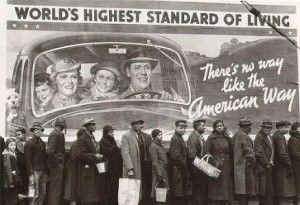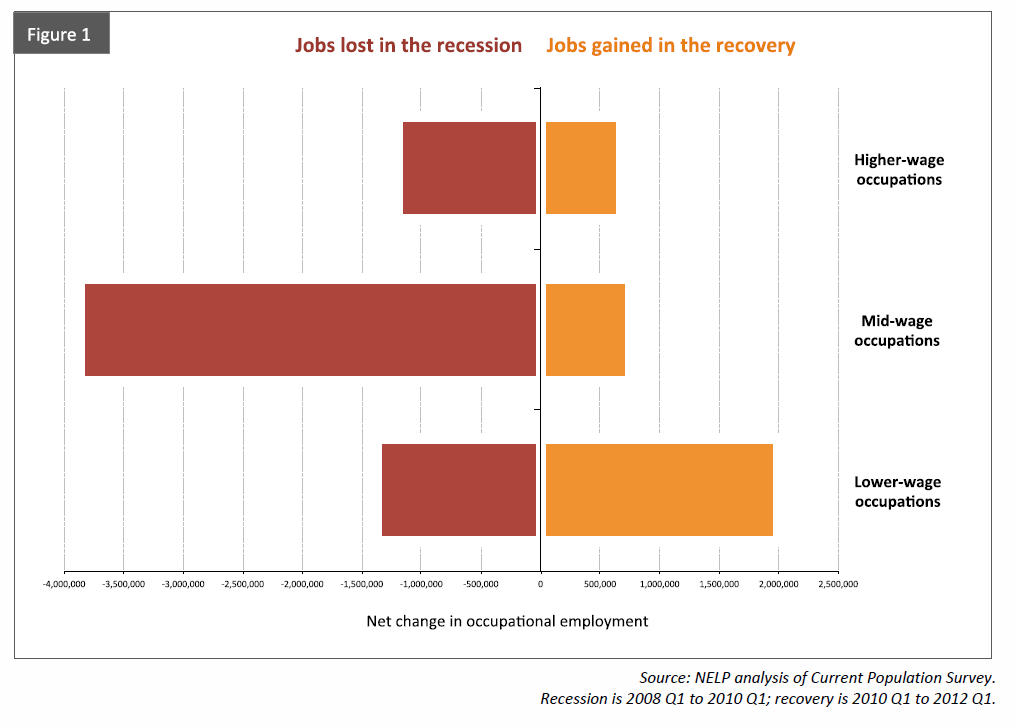Why low-wage jobs boom is good news for California
By Wayne Lusvardi
Is there anything for California to celebrate about the news that there has been a recent “explosion” of low wage jobs? Not according to the union-backed National Employment Law Project’s new study, “Low Wage Recovery and Growing Inequality.” After reading NELP’s study, one might wrongly conclude it is better to be unemployed than working. But the recovery of low-wage jobs is something to celebrate.
Assuming the data analysis in NELP’s new national study is reliable, about 58 percent of jobs created during the economic recovery since 2008 have been low-wage job positions paying $13.83 per hour or less. According to NELP, about 46 percent of those re-employed full-time workers were earning as much as the jobs they lost. Another third took a pay “haircut” of 20 percent or more.
In other words, about 70 percent of lower-wage earners were able to recover jobs at more or less the same pay level as they had before the recession. NELP sees the wage cup 30 percent empty but the data indicate that it is nearly 70 percent full. That is good news, not bad news.
Even in boom times, not all workers who lose their jobs later find the same or higher wage jobs. That only 30 percent of new lower-wager job hires have found work at 20 percent less than their previous wage in a recession is not all that bad news.
Not Much Good News For Mid-Wage Workers
It is mid-wage level workers who have experienced the greatest recession losses and only modest recovery gains. Lower wage occupations reflected 21 percent of recession job losses, but 58 percent of recovery growth. But mid-wage jobs made up 60 percent of recession job losses, but only 22 percent of job growth. And higher wage jobs were 19 percent of recession losses but only 20 percent of job recovery.
While NELP keeps yelping that a “rise inequality continues,” their own data indicate otherwise. Lower wage jobs have recovered better than mid-to-higher wage jobs.
The wage market needs to find a price level that can clear the market from the abnormal levels experienced during the Housing Bubble for the economy to recover.
Wage Market Needs to Adjust from Bubble Levels
As economist John Tamny recently wrote:
“Considered in light of today’s high unemployment, we have a great deal of labor inventory, and a major factor here is 99 weeks of unemployment benefits that make luring potential workers from the sidelines too expensive amid modern market realities. After that, whatever one’s opinion of Obamacare, the latter foretells great per employee expense for companies; the law making it even more expensive for businesses to hire workers. Labor is a cost, and governmental mistakes at the moment are not allowing the cost of labor to fall to market clearing levels.”
According to Tamny, the Obama administration is violating four essentials to putting people back to work: 1) taxes are set to go up on businesses; 2) regulations are more difficult, squelching profit-seeking; 3) there is an unwillingness to remove trade barriers; and 4) the administration continues to pursue policies that weaken the dollar. As Tamny puts it: “Obama is begging voters to make him a one-term president.”
Quantitative Easing 3 Won’t Be Easy
The Federal Reserve is pursuing yet another round of what is called “Quantitative Easing” — or the printing of more dollars — to ease the impacts of another recession. This will result in diluting the purchasing power of the dollar.
Lance Roberts, CEO of Streetalk Advisors, says a proposed “Quantitative Easing 3” (QE3), will beat consumers up because commodity prices such as oil and food prices will jump, as more dollars will be needed to purchase those goods than before.
Bottom line: Whatever wage earners are recovering in wages is going to be partly eroded by monetary inflation due to the Federal Reserve’s coming Quantitative Easing 3 policy.
What the right hand of the private labor market giveth, the left hand of government-induced inflation partly taketh away.
On Labor Day 2012, two cheers for the labor market. No cheers for the coming government-caused inflation.
Related Articles
Do high taxes cost state jobs?
AUGUST 30, 2010 By JOHN SEILER It’s become a commonplace among many Republicans, conservatives and libertarians that California’s high-tax climate
Prop 24: Fairness or Penalty?
SEPT. 30, 2010 By KATY GRIMES It’s not so unusual to hear people making disparaging comments about one another at
Whitman: banal and unconvincing
JUNE 1, 2010 Steven Greenhut: I have rarely seen a political candidate who avoided taking tough stances during the election




